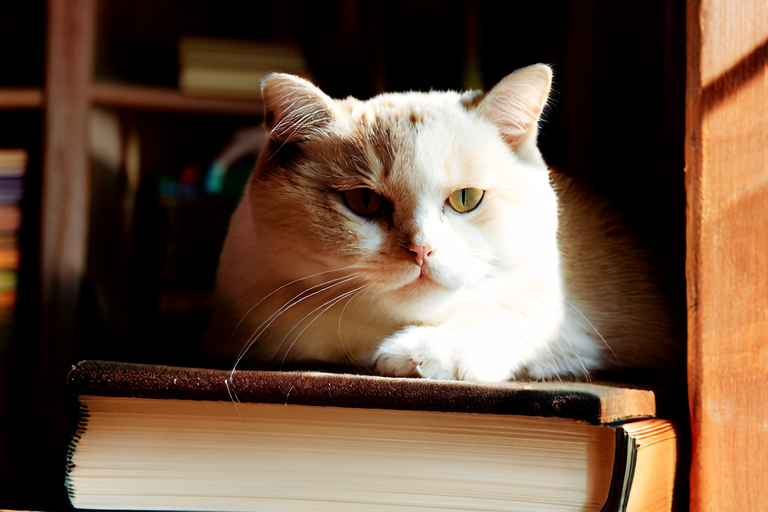Scottish Fold Cats: Unique Appearance and Gentle Companions
The Scottish Fold is a breed of cat known for its unique appearance and gentle personality. With their distinctive folded ears, round faces, and large expressive eyes, they have become popular pets around the world. In this article, we will explore the physical characteristics, temperament, behavior, care requirements, and fascinating history of these charming cats.
Physical Characteristics
The most striking feature of the Scottish Fold is its ears, which fold forward and downward in a distinctive manner. This fold is caused by a genetic mutation that affects the cartilage of the ear. Not all kittens born to Scottish Fold parents will inherit this trait; only about half do. Those that do not develop the folded ears are known as “straight-eared” or “lop-eared” Folds and are just as loving and loyal as their folded-ear counterparts.
Scottish Folds have rounded heads with full cheeks and prominent whisker pads. Their eyes are large and wide-set, giving them an alert and curious expression. The breed comes in a variety of colors and patterns, including solid colors, tabby, bicolor, and pointed. Their coats can be either short or long, but both varieties are dense and plush, providing excellent insulation against cold weather.
Temperament and Personality
Scottish Folds are known for their friendly and affectionate nature. They are typically very social animals that enjoy spending time with their human companions. These cats tend to form strong bonds with their owners and often seek out their company. They are generally good with children and other pets, making them ideal family pets.
One of the most endearing traits of Scottish Folds is their tendency to be lap cats. Many enjoy curling up next to their owners on the couch or sitting quietly beside them while they work. Their calm demeanor and gentle disposition make them easy to handle and care for, even for first-time cat owners.
Behavioral Traits
Scottish Folds are intelligent and curious cats that enjoy exploring their surroundings. They are generally quiet and well-behaved, rarely causing trouble or making noise. However, they do require mental stimulation to prevent boredom, so it’s important to provide them with toys and activities to keep them engaged.
These cats are also known for their adaptability. They can thrive in a variety of living situations, from small apartments to large homes. As long as they have access to comfortable sleeping areas and plenty of attention from their humans, they will be content. They tend to be less active than some other breeds, preferring to conserve their energy for napping or lounging.
Care Requirements
Diet
Like all cats, Scottish Folds need a balanced diet that provides them with the nutrients they need to stay healthy. High-quality commercial cat food that meets the nutritional requirements set by organizations such as the Association of American Feed Control Officials (AAFCO) is a good option. Wet food can be offered in addition to dry food to increase hydration and provide variety in their diet.
It’s important to avoid overfeeding your Scottish Fold, as they can be prone to obesity. Portion control and regular exercise can help maintain a healthy weight. Consult with your veterinarian to determine the appropriate amount of food for your cat based on their age, size, and activity level.
Health Care
Scottish Folds are generally healthy cats, but like all breeds, they may be susceptible to certain health issues. One of the most common concerns for this breed is osteochondrodysplasia, a condition related to the same genetic mutation that causes their folded ears. This condition can lead to joint problems, particularly in the tail, legs, and spine. Regular veterinary check-ups and x-rays can help monitor for signs of this condition.
Other potential health issues include cardiomyopathy, a heart disease that can affect some cats, and polycystic kidney disease, which can cause kidney failure in older cats. Routine veterinary care, including vaccinations, dental cleanings, and parasite prevention, is essential for maintaining your Scottish Fold’s overall health.
Interactive Play
Providing your Scottish Fold with interactive playtime is crucial for their physical and mental well-being. Use toys that encourage them to chase, pounce, and stalk, such as feather wands or laser pointers. Rotate their toys regularly to keep things interesting and prevent boredom.
In addition to playtime, consider setting up climbing structures or perches for your cat to explore. This will give them opportunities to stretch their muscles and satisfy their natural urge to climb and observe their surroundings from high vantage points.
History and Fun Facts
The Scottish Fold breed originated in Scotland in the 1960s when a farmer named William Ross noticed a white barn cat with unusual folded ears at his neighbor’s farm. He bred this cat with a local tabby, and their offspring included some kittens with folded ears. These cats were then selectively bred to preserve the trait.
The breed gained popularity in the United States in the 1970s and has since become one of the most beloved breeds worldwide. Despite their widespread appeal, there are still some controversies surrounding the breeding of Scottish Folds due to the potential health risks associated with the genetic mutation responsible for their folded ears. Many breeders and organizations advocate for responsible breeding practices to minimize these risks.
One fun fact about Scottish Folds is that they are often referred to as “cute potato heads” because of their round faces and large eyes. Another interesting tidbit is that some people believe that their folded ears make them look like they are always listening, giving them an attentive and observant appearance.
Scottish Folds are truly unique and delightful companions. Their charming appearance, gentle temperament, and adaptability make them wonderful additions to any household. By providing them with proper care and attention, you can ensure that your Scottish Fold lives a happy and healthy life.
